Negros Occidental is home to another destination held up as an exemplar of ecotourism and community development, much like Danjugan Island in its southern part. Sagay City, perched on the northern tip of the province like an ice cream cone overlooking the Visayan Sea, is home to a number of eco-tourism hotspots that does wonders for both its community members and its natural environment.
 |
| Carbin Reef |
Over the course of four days, we made our way to every corner of this laidback city, taking us deep into a mangrove forest to a sand bar leading to an artist village where we were graced with the presence of an irrepressible art maestro.
Suyac Island Eco-Park
On Suyac Island, where there is a mangrove forest spanning 15 hectares and a mainland covering 1.8 hectares, the local community presently sustains and manages their own eco-park.
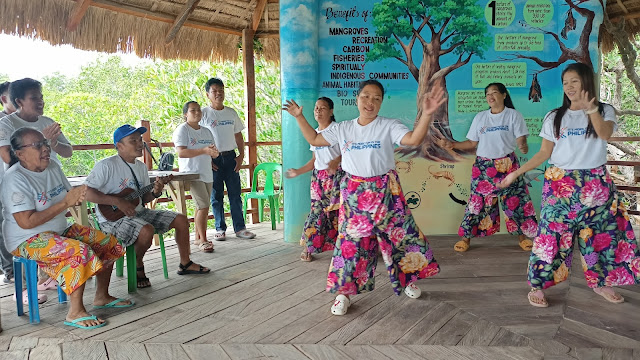 |
| The community in Suyac Island acts as a whole in managing the island. |
The local government tourism units' efforts, coupled with training and support from the Tourism Promotions Board of the Philippines, have resulted in the community adopting sustainable tourism practices.
 |
| The community-based tourism program in Suyac Island is something to replicate |
Visitors to the island are welcomed with a song and dance performance based on local culture and stories. Afterward, trained guides from the community takes the guests through the forest while imparting essential facts about different mangrove tree species, before concluding the tour with a delectable lunch of local fare.
The mangrove forest's nine species of mangrove trees proved their importance during Typhoon Yolanda. One of the elderly members of the community shared that other than fallen trees and damaged roofing, the island was spared from storm surge that proved deadly in many coastlines along the path of Yolanda.
"The mangrove saved our community, we just stayed in our homes, and I even helped deliver a baby boy who his mother named Yolando", she told us in her local language.
 |
| Lapus-Lapus Floating Cottage is another eco-tourism site in Sagay |
"Sustainable Tourism" is a phrase so often bandied about that it has begun to sound like a buzzword, despite the reality that its success requires, at its heart, the willingness and ability to first establish conversation, implement best practices, and get a deeper understanding and involvement of the local community.
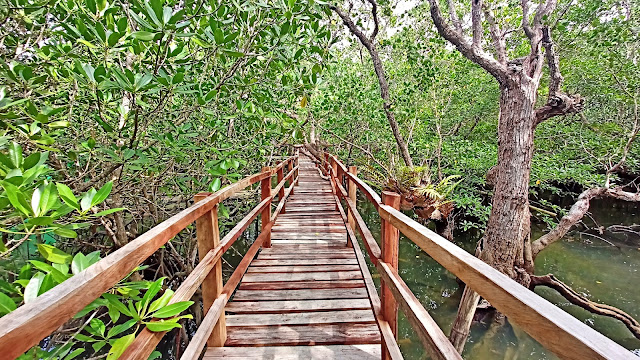 |
| A long wooden pathway takes you through the healthy mangrove forest in the island |
Here in Suyac Island however, the LGU and the island residents have shown that "sustainable tourism" is more than just a catchphrase; it is a real and effective way for a community to take pride in its environment, improve it, and create economic independence for itself.
Museo Sang Bata Sa Negros Children’s Museum
Real people empowerment is bounded by no age range. Thus, why here at the Museo Sang Bata Sa Negros (MSBN), youngsters aged 8 to 12 acts as guides for visitors. Through the years, the museum’s "Junior Guide Program" has helped many youngsters develop a lifelong appreciation for the sea. In fact, one of the first junior guides, who began in third grade, is now taking up a Marine Biology course.
 |
| The museum conducts other meaningful programs |
The museum was set up to spread marine wildlife awareness especially among the new generation, particularly the ones who live in Sagay where a large percentage of the local population relies on marine resources for livelihood.
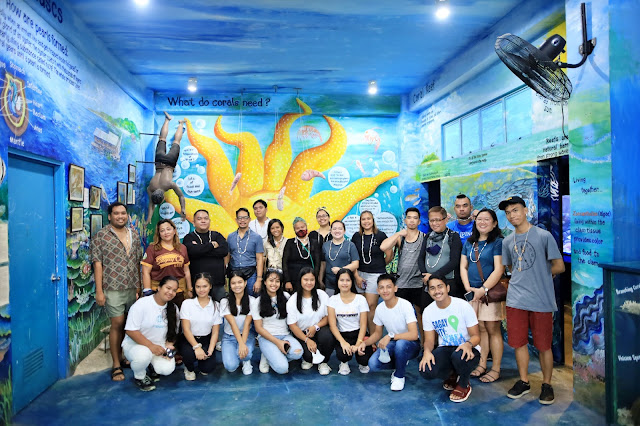 |
| including the "Marine Conservatin Education Program" that trains public elementary teaches to raise awareness for the marine environment" |
During our visit, junior guides who joined the program in their early grade school years toured us around the museum and imparted much knowledge even I never knew beforehand.
Art Community in Bougainvillae, Old Sagay
"Imagine living in a community where an artist of Nunelucio Alvarado's stature lives?" wonders Helen Arguelles, Tourism Officer of Sagay City.
 |
| The maestro is all smiles when he greeted us |
Indeed, Alvarado's creativity has filtered down to his neighborhood in Bougainvillae, Old Sagay, as evidenced by the brilliantly painted homes, folk dancing skills of schoolchildren, and countless others he has impacted to explore other art forms.
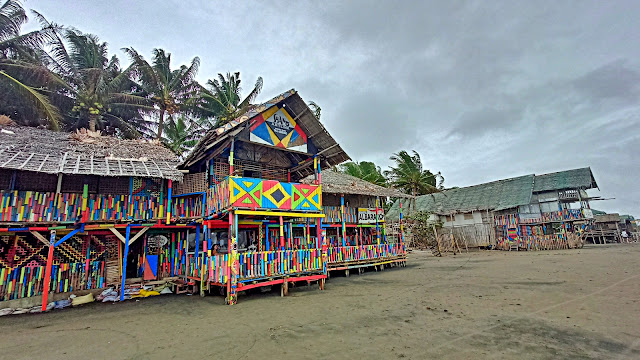 |
| This colorful café slash gallery is just a stone throw away from the house of Maestro Nune and his wife Sally |
With a few quaint cafes along its long shoreline, the locality has been a must-visit in the city since becoming a creative hub for artists.
 |
| This doggo is living a chill kind of life here |
Twice nominated for the National Artist honor, Maestro Nune was a staple in Manila's art scene in his earlier years. Many of his paintings can be found in museums such as the National Museum of the Philippines, the Singapore Art Museum, and the Fukuoka Asian Art Museum, to mention a few.
 |
| Group photo with Maestro Nunelucion Alvarado and his wife Sally |
He and his wife Sally now spend their time in his hometown of Sagay in their hand-hewn and painted art studio, creating new works every day while overlooking the 32,000-hectare Sagay Marine Reserve.
Trisikad Tours
The same neighborhood, known as the "community of colors," and where Maestro Nune resides, can be explored from the seat of a "trisikad," a bicycle outfitted with a sidecar that can carry two passengers. Labeled as the “sikad” tours, it is yet another one of the many community-based tourism programs of Sagay City.
 |
| This multi-colored trisikad takes guests on a tour of this vibrant community |
Visitors can take a sikad ride through the community to see the colorful murals painted by local volunteer artists under the guidance of Syano Artlink, where Alvarado serves as Art Director.
Carbin Reef
Shaped like a tongue wagging out of Rolling Stones’ hot lips logo, Carbin Reef is part of the 32,000-hectare Sagay Marine Reserve established in 1999. The sandbar itself hides a gem of marine life in its immediate 200-hectare area. Guests to Carbin Reef can enjoy an array of water activities such as snorkeling, free diving, scuba diving, beach bumming or simply taking drone and Instagram photos.
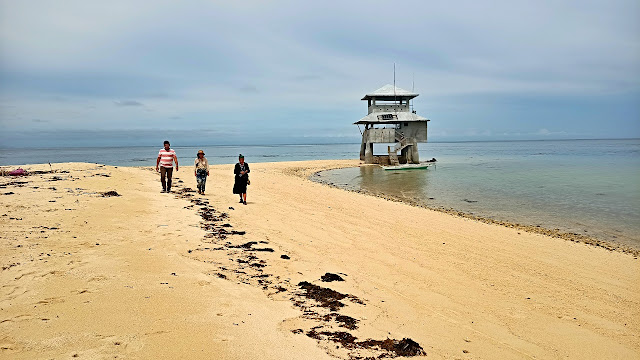 |
| Had a fun time walking over the sandbar of Carbin Reef |
On our final day before we headed to another province in Capiz, I took our sweet time here in Carbin Reef by just walking the end-to-end tip of the sandbar while flying my drone. As beautiful it is at eye-level, the view from above is equally or even more impressive. I can see clearly why Sagay City and the TPB are working tirelessly to ensure such eco-tourism destinations like the Carbin Reef should be well taken care of and managed properly.
TPB’s 3-day CBT Workshop
Part of the reason why we were in Sagay was also to cover the three-day Community-Based Tourism (CBT) workshop conducted by the Tourism Promotions Board of the Philippines (TPB), the marketing arm of the Department of Tourism (DOT).
 |
| Some members from the various eco-tourism communities poses for a group shot during the workshop |
As early as prior to the pandemic, then TPB COO Marie Venus Tan and TPB marketing specialist Alberto Gadia Jr. had planned to hold a workshop in Sagay after being impressed by the city's eco-tourism potential. Through the efforts of Gadia Jr. and the support of current TPB COO Marga Nograles, the workshop caravan finally arrived in Sagay City.
Stakeholders from five eco-tourism destinations in Sagay City attended the workshop conducted by Brand Builder and Idea Accelerator Apple Allison, with support from the LGU led by Sagay City Tourism Officer Helen Arguelles.
Krisma Rodriguez, Director of Tourism Region 6, also attended the workshop and emphasized the importance of providing necessary training to community members in order to tap into the tourism industry not only as a means of earning a living, but also as a "tool that protects the environment if done correctly."
Following the workshop, which covered a variety of topics including Business Development, Brand Marketing, Social Media Marketing, School of Sales and Influence, the TPB also donated starter kits to three eco-tourism associations, including fiberglass kayaks to the Suyac Island Eco-Tourism Attendants Association and Lapus-Lapus Floating Cottages Association, as well as other livelihood materials to the Bouganvillea Sikad Guides Association.
This article first appeared on the Tourism section of BusinessMirror
Photos 1, 3 & 4 courtesy of Sagay Tourism
























